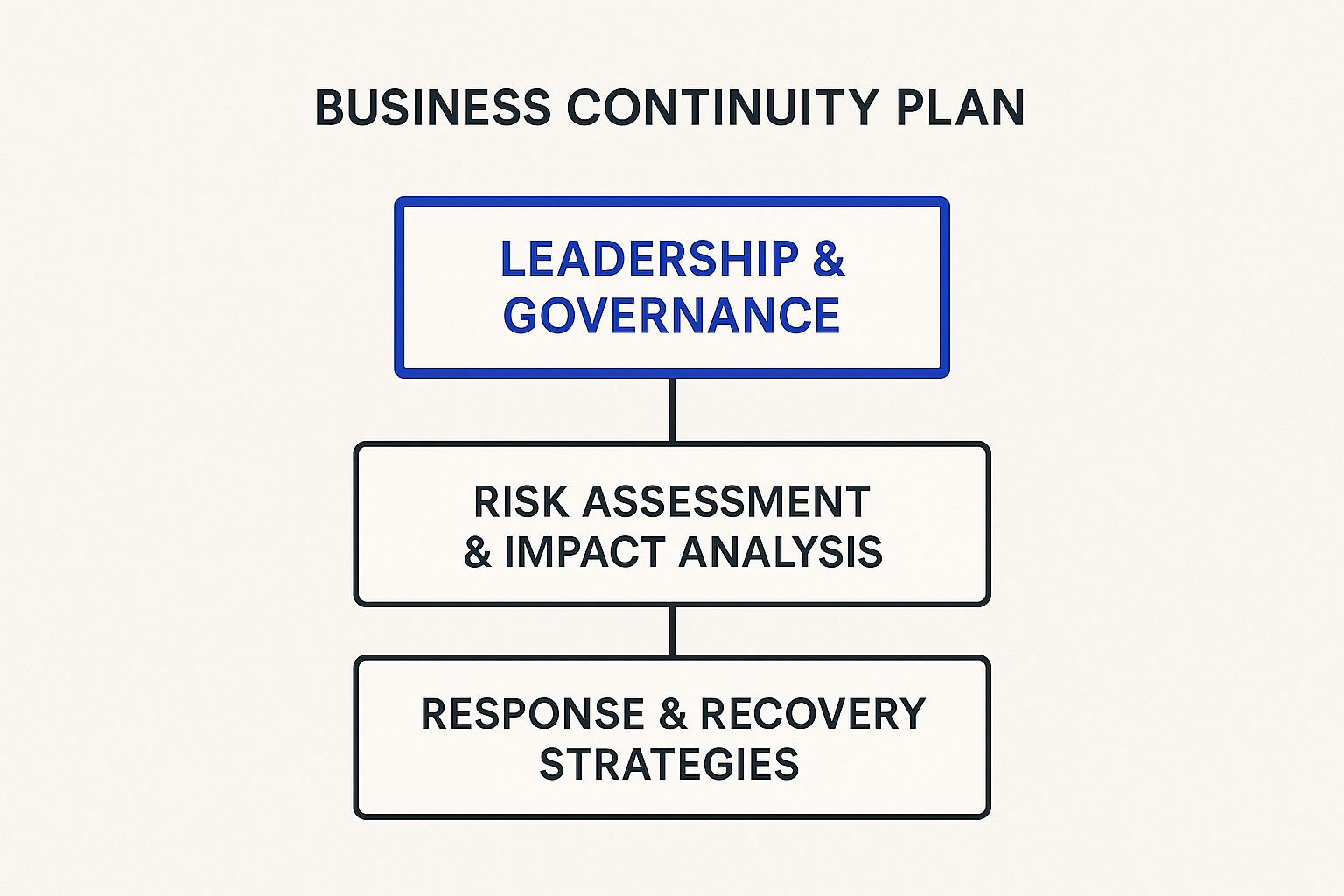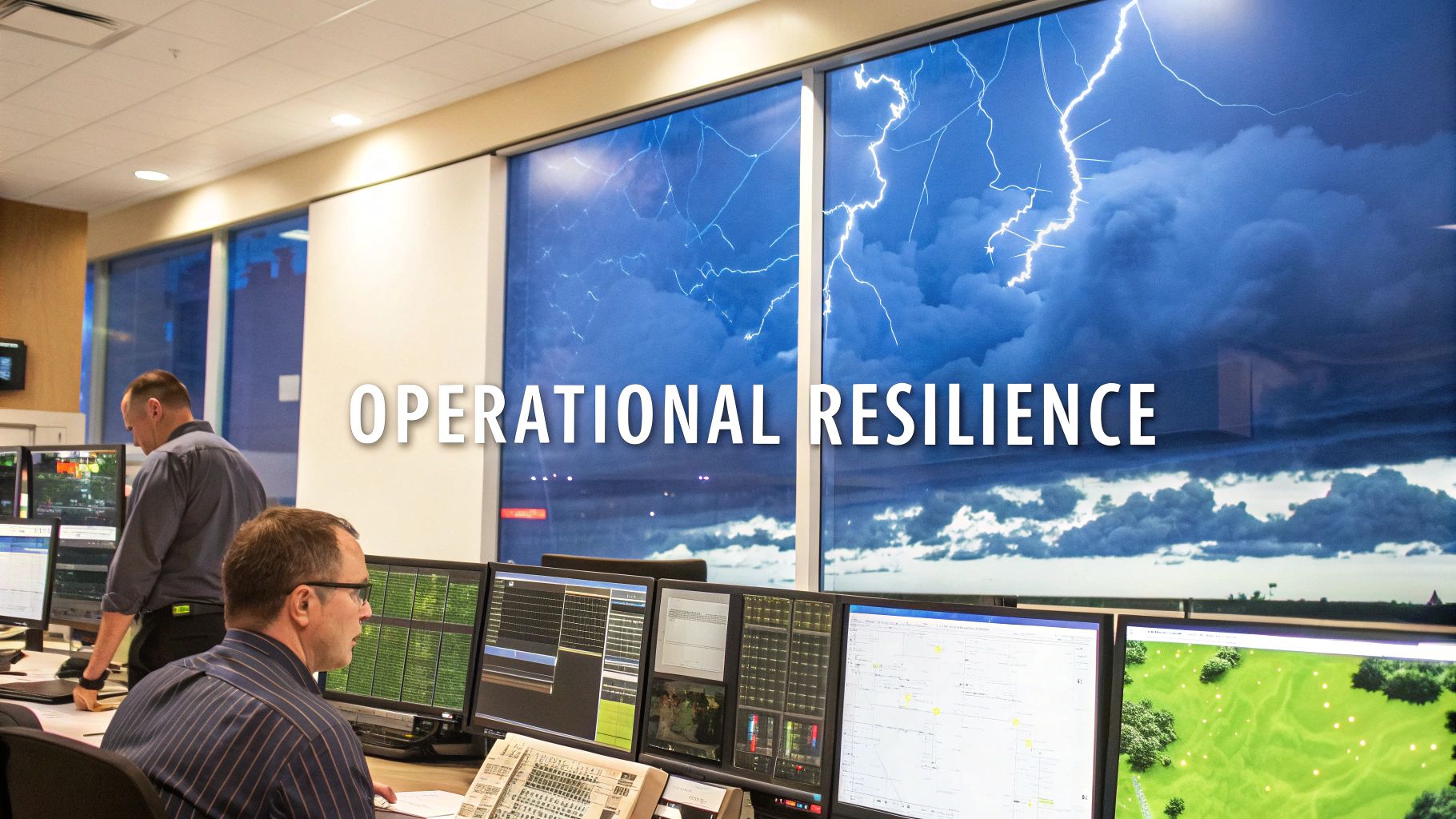When a powerful hurricane barrels toward the Texas coast or a sudden winter storm threatens the state's power grid, your operations don’t have to grind to a halt. Instead, they can adapt, endure, and recover.
This resilience is the core of business continuity planning (BCP). It's the detailed, data-driven strategy that ensures your business can withstand a significant disruption and continue to serve its customers.
The Foundation of Operational Resilience

A business continuity plan is more than a document collecting dust on a server—it’s a living playbook for a crisis. It lays out a structured framework that allows a company to maintain, or at least quickly restore, its most critical functions after an unexpected event. These disruptions can range from the extreme weather Texas knows all too well—like hurricanes and deep freezes—to broader threats like a major supply chain collapse or a cyberattack.
For Texas industries, from the sprawling petrochemical plants along the Gulf Coast to the manufacturing hubs in Dallas-Fort Worth, understanding what business continuity planning is becomes the first step toward building tangible resilience. A common point of confusion, however, is its relationship with disaster recovery.
Disaster recovery (DR) is just one piece of the BCP puzzle, not the whole thing. DR is laser-focused on getting your IT infrastructure and data back online after an incident. BCP, on the other hand, is the holistic strategy covering your entire operation: your people, processes, physical assets, and stakeholder communications.
Key Aspects of a Business Continuity Plan
A robust BCP examines the full scope of your operations. It systematically prepares your organization by zeroing in on a few core areas:
- People: This means ensuring your employees are safe and establishing clear communication channels. Everyone must know their role and responsibilities when a crisis hits.
- Processes: Here, you identify the essential business functions that must continue operating, no matter what, and map out the workarounds to make it happen.
- Assets: It's about protecting your physical locations, equipment, and inventory from damage while lining up alternative resources as a contingency.
This proactive approach shifts a business from a reactive scramble to a state of calm preparedness. Instead of panicking when a disruption hits, a company with a strong BCP executes a well-rehearsed plan, mitigating downtime and financial losses. More than that, it builds confidence with employees, customers, and partners by demonstrating your organization is built to last.
Please note: ClimateRiskNow does not sell insurance or financial products. The information provided on climaterisknow.com is for educational purposes only and does not constitute financial advice or an insurance recommendation.
Why Business Continuity Is No Longer Optional

In an environment marked by volatile weather and unpredictable economics, treating business continuity as a low priority is a gamble most Texas companies cannot afford. The COVID-19 pandemic served as a brutal, universal lesson, showing how fast an unprepared business can falter when a major disruption strikes.
Companies with solid continuity plans already in place were able to pivot. They kept their core operations running and protected revenue while competitors were left scrambling. This isn't just about surviving one event; it's about building lasting operational resilience and earning the trust of your customers and partners. The cost of inaction—in both financial and reputational terms—is staggering.
The High Price of Unpreparedness
The COVID-19 crisis laid bare a massive gap in corporate readiness. A 2020 Mercer survey found that a shocking 51% of companies worldwide had no business continuity plan at all. The consequences were devastating, with an estimated 100,000 small U.S. businesses permanently closing because they couldn't adapt.
That data paints a stark picture: failing to plan is planning to fail. For Texas industries like manufacturing, energy, and logistics, a single disruption can bring production lines to a dead stop or sever vital supply chains, triggering a cascade of financial losses and fractured client relationships.
A business continuity plan does more than protect your bottom line; it safeguards your reputation. In a crisis, customers and partners remember which companies were reliable and which ones went dark.
Building Trust Through Reliability
A well-executed BCP sends a clear, powerful signal. It tells the market that your organization is stable, well-managed, and capable of weathering storms—both literal and figurative. That preparedness becomes a significant competitive advantage, especially in sectors like energy and construction where operational uptime is paramount.
Consider the impact on a major construction project or an agricultural operation. Delays from extreme weather are always costly, but having a pre-determined plan minimizes downtime and keeps critical work on track. This reliability strengthens your market position and builds the foundation for long-term partnerships.
For Texas businesses, integrating BCP with smart climate change adaptation strategies is key to building this type of all-weather resilience. By truly understanding what business continuity involves and committing to it, you're not just managing risk—you're investing in a future where your business can thrive, no matter what comes its way.
The Building Blocks of an Effective BCP
Crafting a solid business continuity plan isn't as daunting as it sounds. While every Texas business has unique challenges—from a petrochemical plant on the coast to an agricultural operation in the Panhandle—the framework for a BCP is remarkably consistent. It’s all about a clear, logical progression.
By breaking the process down, you can move from a state of uncertainty to one of actionable preparedness. This structured approach takes business continuity planning from an abstract idea and turns it into a practical tool for managing your business through a crisis.
Let's walk through the core stages of building a plan that actually works.
Stage 1: Business Impact Analysis
The first and most important step is the Business Impact Analysis (BIA). Think of this as the diagnostic phase. Its entire purpose is to identify which parts of your business are absolutely essential for survival.
You must ask the tough questions: If a winter storm knocks out the power grid for a week, which processes must we restore first to prevent a complete operational failure? A BIA forces you to prioritize by quantifying the operational and financial impacts of a disruption over time, establishing your Recovery Time Objectives (RTOs).
Stage 2: Risk Assessment
Once you know what's most critical, you need to identify what threatens it. The Risk Assessment stage is where you pinpoint the specific threats relevant to your operations. For a logistics company in Houston, this is almost certainly hurricane-driven flooding. For a manufacturing plant near Dallas, the focus might be on tornado risk and supply chain disruptions. For an energy producer in the Permian Basin, it could be extreme heat stressing equipment and personnel.
This isn't about vague worries; it's about data. A proper risk assessment looks at both the likelihood of a threat occurring and the potential severity of its impact. This is where you connect external risks, like weather events, to your specific internal vulnerabilities. To see how deeply weather can affect logistics, explore our guide on building supply chain resilience against extreme weather.
The diagram below shows how leadership, risk analysis, and response strategies all come together to form the core of a resilient BCP.

This visual drives home a key point: an effective BCP must be a top-down initiative. When leadership is committed, it fuels the deep analytical work required to build smart, on-the-ground response tactics.
Stage 3: Strategy Development and Implementation
With a clear picture of your critical functions and the threats they face, you can finally build your response strategy. This is the "how" stage. How, exactly, will you mitigate risks and maintain operations? This might mean:
- Securing backup power generators.
- Identifying alternate suppliers or shipping routes.
- Setting up remote work capabilities for key staff.
- Hardening facilities against wind or flood damage.
This all comes together in a formal table that outlines the key components of any robust BCP.
Key BCP Components and Their Purpose
| Component | Primary Objective | Key Activities |
|---|---|---|
| Business Impact Analysis | Identify and prioritize critical business functions. | Quantify financial and operational impacts of disruption over time. |
| Risk Assessment | Pinpoint specific threats and vulnerabilities. | Analyze the likelihood and severity of potential threats like weather events. |
| Strategy Development | Design specific recovery and continuity strategies. | Arrange for backup power, alternate suppliers, and remote work capabilities. |
| Plan Implementation | Document, train, and test the BCP. | Create plan documents, conduct drills, and train employees on their roles. |
This table provides a high-level map, but the final, crucial step is Plan Implementation. This is where you document everything, train your teams, and ensure everyone knows their role when things go sideways.
A plan that sits on a shelf is just a theory. You must test it. Regular drills and exercises are essential for validating your strategies and building the organizational muscle memory you'll need when a real crisis hits. This is what turns your BCP from a document into a living, effective defense for your business.
Navigating Today’s Threat Landscape
A static, check-the-box business continuity plan no longer cuts it. The risks facing Texas operations today are more interconnected and unpredictable than ever, which means your strategy must be just as dynamic. For Texas industries, this means confronting a dual threat of sophisticated digital attacks and increasingly severe extreme weather events.
These dangers do not exist in separate silos. A cyberattack can easily cripple the very systems you need to coordinate a hurricane response. A widespread power outage from a winter storm can, in turn, expose critical digital vulnerabilities. This convergence of physical and digital risk is forcing a change in how we approach business continuity. It must be woven directly into your cybersecurity and physical security measures.
The Rise of Dual Threats
The data paints a clear picture of these intertwined risks. A 2023 report highlighted that 83% of attacks on businesses were launched by external actors. Simultaneously, the frequency and intensity of natural disasters like hurricanes and heatwaves are increasing, putting immense pressure on physical operations. This dual-threat reality has very real consequences for Texas businesses. Your BCP must be ready for a ransomware attack locking down your logistics software in the same week a brutal heatwave is straining the power grid and putting your people at risk.
A modern BCP is a defense fought on two fronts. It must anticipate a cyber breach happening while a major storm is making landfall, because one crisis will absolutely amplify the other.
Weather and Infrastructure Vulnerabilities
If you are a leader in Texas energy, construction, logistics, manufacturing, or agriculture, extreme weather isn't just a line item—it's a primary operational threat demanding specific, localized planning. The challenges are vastly different across the state, from Gulf Coast hurricanes to Panhandle blizzards.
An effective business continuity plan must get specific about these regional realities:
- Hurricanes and Flooding: Facilities along the Gulf Coast need hardened structures, along with clear protocols for evacuations and shutdowns. Our guide on how to prepare for hurricane season offers a game plan for securing your assets before a storm hits.
- Extreme Heat and Drought: Operations in Central and West Texas must plan for prolonged heatwaves that impact worker safety, water supplies, and the stability of the electrical grid.
- Winter Storms and Freezes: Winter Storm Uri was a stark reminder. It showed how a few days of extreme cold can trigger catastrophic failures in power and water infrastructure, bringing operations to a statewide halt. Regulations like those from the Public Utility Commission of Texas (PUCT) now require weatherization preparedness, making BCP a compliance issue.
A truly resilient BCP doesn't come from a generic template. It is built on location-specific risk data to address the most likely and high-impact threats to your specific facilities. This is how you prepare your business for the complex realities of today’s risk environment.
Keeping Your Business Continuity Plan Relevant

Putting a business continuity plan on paper is a major accomplishment, but it's really just the starting line. A plan that sits on a shelf, untested and unread, is nothing more than a paperweight when a real crisis hits. For businesses in Texas, the threat landscape is anything but static, which means your BCP must be a living document that adapts right along with it.
A plan drafted even a few years ago might not account for a new facility, a critical supplier change, or the increasing intensity of storms. Regular maintenance is what keeps your response strategies sharp and tethered to your current operational reality. This is the difference between a plan that looks good and one that actually works.
From Theory to Practice Through Testing
Testing is where the rubber meets the road. It’s how you find the cracks in your plan before a real disaster exposes them. For a Texas-based operation, a test might mean simulating a sudden grid failure during a deep freeze or running a drill for a supply chain cutoff after a hurricane makes landfall on the Gulf Coast.
Different situations demand different kinds of tests, and each one serves a unique purpose:
- Tabletop Exercises: These are guided "war-gaming" sessions where your crisis team talks through a simulated event, ensuring everyone understands their role and the procedural flow without high stakes.
- Walk-Throughs: A step up from tabletop exercises, team members physically go through their response duties at their assigned posts, checking equipment and confirming processes are practical.
- Full-Scale Drills: This is the most intense form of testing, designed to mimic a real-world event as closely as possible. It could involve activating a backup site, switching to generator power, and coordinating with emergency services.
The point of a test isn't to get a passing grade; it's to find the flaws. Every gap you identify—whether it’s a communication breakdown or a piece of equipment that fails—is a valuable opportunity to strengthen your plan and build true resilience.
Training and Continuous Improvement
You can have the most brilliant plan in the world, but it’s completely useless if your people don't know how to execute it under pressure. That’s why consistent training is so vital. It turns a documented strategy into an instinctive, coordinated response from everyone, from the executive team down to the facility floor.
After every test or drill, conduct a thorough debrief. What went right? Where did things fall apart? The insights gained here provide the hard data needed to refine your plan, update contact lists, and adjust recovery timelines. This constant cycle of testing, analyzing, and improving is the engine that keeps your BCP effective.
Real-world events offer the most powerful case studies. For instance, reviewing the lessons learned from Hurricane Harvey shows exactly how post-disaster analysis helps Texas businesses prepare for the next one. This commitment to improvement is central to what business continuity planning truly means today.
Answering Your Key BCP Questions
As business leaders across Texas develop their continuity plans, a few practical questions almost always come up. Getting clear, straightforward answers is essential to building a plan that works when a hurricane, freeze, or flood hits.
Let’s dig into some of the most common ones.
How Does a BCP Differ from a Disaster Recovery Plan
This is a critical distinction. It's easy to use the terms interchangeably, but they are fundamentally different. Think of it this way: a Disaster Recovery (DR) plan is tactical, while a Business Continuity Plan (BCP) is strategic.
Your DR plan is all about the technology. It’s the specific, nuts-and-bolts playbook for restoring your IT infrastructure—servers, software, and data—after a crisis. The DR plan gets the lights blinking on the servers again.
The BCP is the bigger picture. It’s the holistic strategy that keeps the entire business operational while the IT team is busy executing the DR plan. It covers your people, critical processes, physical assets, and stakeholder communications. In short, DR gets the technology running; BCP keeps the business running.
Is Business Continuity Planning Only for Large Corporations
Absolutely not. It's a common misconception that BCP is just a "big company" thing. While a massive petrochemical facility’s plan will naturally be more complex than one for a mid-sized agricultural business, the core principles are essential for all.
In fact, BCP is often more critical for small and medium-sized businesses in Texas.
Smaller companies typically have fewer resources and less cash reserves to absorb the shock of a prolonged shutdown. A focused, scalable BCP isn't just a "nice-to-have"—it's a powerful tool for survival and a real competitive advantage.
How Often Should We Test and Update Our BCP
A BCP that sits on a shelf is useless. It must be a living document that evolves with your business.
We recommend a complete, top-to-bottom review and update at least annually. But testing should happen more often to build organizational muscle memory.
Quarterly tabletop exercises are a fantastic way to keep your crisis team sharp and their skills fresh. You should also run a more involved, hands-on simulation annually. Most importantly, you must revisit the plan immediately after any major operational change—like opening a new facility, switching a critical supplier, or after weathering a major storm. Our guide on how to prepare for hurricane season can give you a great starting point for those kinds of updates.
Are you prepared for the next high-impact weather event? ClimateRiskNow delivers location-specific risk intelligence to help Texas businesses quantify their exposure to hurricanes, freezes, and floods. Transform complex data into a strategic advantage and safeguard your operations.

